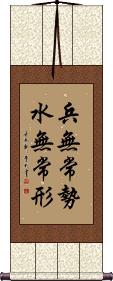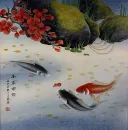Many custom options...
And formats...

I Have Overcome in Chinese / Japanese...
Buy an I Have Overcome calligraphy wall scroll here!
Warriors Adapt and Overcome
Soldiers need a fluid plan
This literally translates as: Troops/soldiers/warriors have no fixed [battlefield] strategy [just as] water has no constant shape [but adapts itself to whatever container it is in].
Figuratively, this means: One should seek to find whatever strategy or method is best suited to resolving each individual problem.
This proverb is about as close as you can get to the military idea of “adapt improvise overcome.” 兵無常勢水無常形 is the best way to express that idea in both an ancient way, and a very natural way in Chinese.
This in-stock artwork might be what you are looking for, and ships right away...
Gallery Price: $61.00
Your Price: $33.88
Gallery Price: $61.00
Your Price: $33.88
Gallery Price: $61.00
Your Price: $33.88
Gallery Price: $240.00
Your Price: $148.88
Gallery Price: $61.00
Your Price: $33.88
Gallery Price: $61.00
Your Price: $33.88
Gallery Price: $61.00
Your Price: $33.88
Gallery Price: $49.00
Your Price: $27.00
Not the results for i have overcome that you were looking for?
Below are some entries from our dictionary that may match your i have overcome search...
| Characters If shown, 2nd row is Simp. Chinese |
Pronunciation Romanization |
Simple Dictionary Definition |
三轉 三转 see styles |
sān zhuǎn san1 zhuan3 san chuan santen |
(三轉法輪) The three turns of the law-wheel when the Buddha preached in the Deer Park: (a) 示轉 indicative, i.e. postulation and definition of the 四諦; (b) 勸轉 hortative, e.g. 苦當知 suffering should be diagnosed; (c) 證轉 evidential, e.g. I have overcome suffering, etc. |
十障 see styles |
shí zhàng shi2 zhang4 shih chang jisshō |
Ten hindrances; bodhisattvas in the stage of 十地 overcome these ten hindrances and realize the十眞如 q.v. The hindrances are: (1) 異生性障 the hindrance of the common illusions of the unenlightened, taking the seeming for real; (2) 邪行障 the hindrance of common unenlightened conduct; (3) 暗鈍障 the hindrance of ignorant and dull ideas; (4) 細惑現行障 the hindrance of the illusion that things are real and have independent existence; (5)下乘涅槃障 the hindrance of the lower ideals in Hīnayāna of nirvāṇa; (6) 細相現行障 the hindrance of the ordinary ideas of the pure and impure; (7) 細相現行障 the hindrance of the idea of reincarnation; (8) 無相加行障 the hindrance of the continuance of activity even in the formless world; (9) 不欲行障 the hindrance of no desire to act for the salvation of others; (10) 法未自在障 the hindrance of non- attainment of complete mastery of all things. v. 唯識論 10. |
好意思 see styles |
hǎo yì si hao3 yi4 si5 hao i ssu |
to have the nerve; what a cheek!; to feel no shame; to overcome the shame; (is it) proper? (rhetorical question) |
押切る see styles |
oshikiru おしきる |
(transitive verb) (1) to face down the opposition; to overcome resistance; to have one's own way; (2) to press and cut |
押しきる see styles |
oshikiru おしきる |
(transitive verb) (1) to face down the opposition; to overcome resistance; to have one's own way; (2) to press and cut |
押し切る see styles |
oshikiru おしきる |
(transitive verb) (1) to face down the opposition; to overcome resistance; to have one's own way; (2) to press and cut |
菩薩聖衆 菩萨圣众 see styles |
pú sà shèng zhòng pu2 sa4 sheng4 zhong4 p`u sa sheng chung pu sa sheng chung bosatsu shōshu |
The bodhisattva saints who have overcome illusion, from the first stage upwards, as contrasted with ordinary bodhisattvas. |
萬箭穿心 万箭穿心 see styles |
wàn jiàn chuān xīn wan4 jian4 chuan1 xin1 wan chien ch`uan hsin wan chien chuan hsin |
lit. to have one's heart pierced by thousands of arrows (idiom); fig. overcome with sorrow; fig. to lambaste; to rip sb to shreds |
The following table may be helpful for those studying Chinese or Japanese...
| Title | Characters | Romaji (Romanized Japanese) | Various forms of Romanized Chinese | |
| Warriors Adapt and Overcome | 兵無常勢水無常形 兵无常势水无常形 | bīng wú cháng shì shuǐ wú cháng xíng bing1 wu2 chang2 shi4 shui3 wu2 chang2 xing2 bing wu chang shi shui wu chang xing | ping wu ch`ang shih shui wu ch`ang hsing ping wu chang shih shui wu chang hsing |
|
| In some entries above you will see that characters have different versions above and below a line. In these cases, the characters above the line are Traditional Chinese, while the ones below are Simplified Chinese. | ||||
Successful Chinese Character and Japanese Kanji calligraphy searches within the last few hours...













